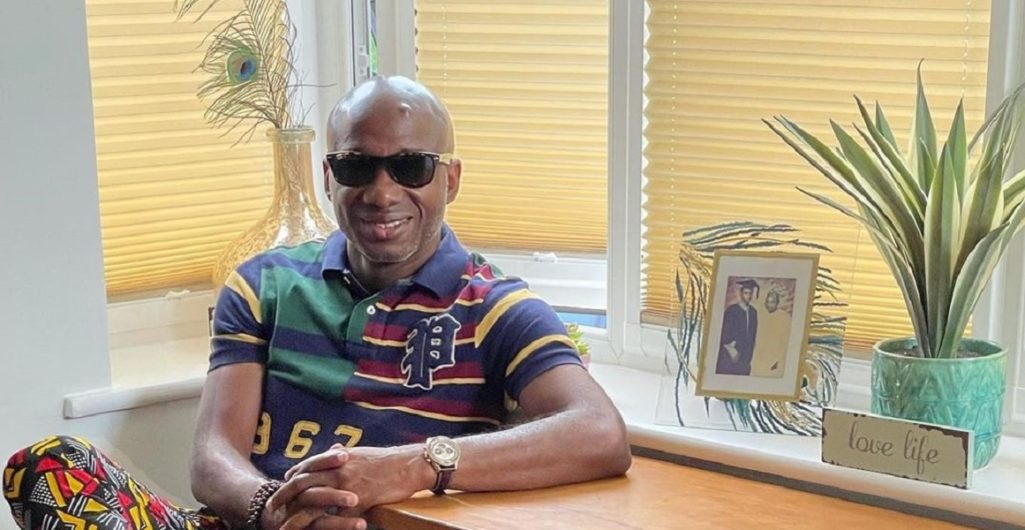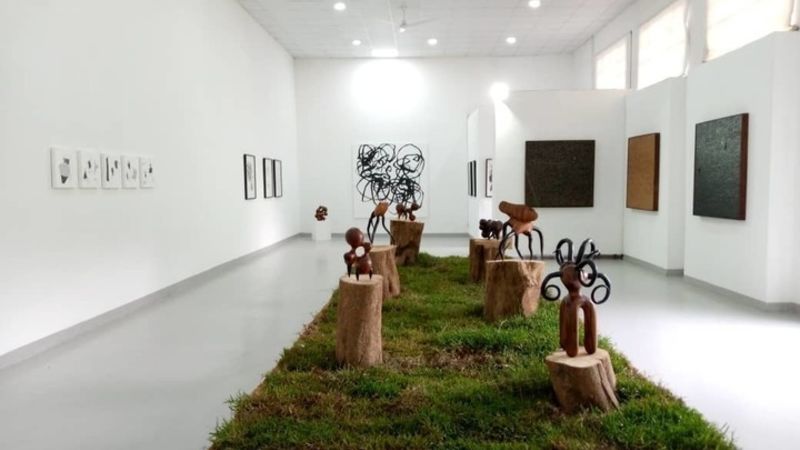Entrepreneur Spotlight: Ibrahim Mahama Sold His Artwork For $1 Million. See How He Is Using The Money


Who is Ibrahim Mahama?
Ibrahim Mahama is a multimedia artist from Ghana. He is arguably the biggest artist in West Africa. The Ghanaian artist primarily works with found objects that are usually considered to have lost purpose. He collects items that are at a certain point of decay or which have residues of certain failures in history. These include jute sacks, shoeshine boxes, sewing machines, documents, photographs, smoked fish grills, and even old planes.
Mr. Mahama uses these evocative materials and objects to create huge and striking artworks, some of which are too massive to be ignored. He also presents such objects in a manner that people can recontextualize them within an exhibition setting. Mahama is the founder of The Savannah Centre for Contemporary Art. This is a non-profit exhibition, residency, and research center located near his home city, Tamale.
He is known internationally for stitching jute sacks and using them to drape buildings. In the past, he has exhibited his work in different international exhibitions. Even with his international scope, Mr. Mahama enjoys investing in his country, Ghana. He explains,
“I always think in Ghana you can negotiate yourself anywhere for artistic things to happen, whereas, in other contexts, there are so many rules, regulations, and policies, a lot of which make it impossible for you to be able to dream a thing.”

In 2019, The Africa Report featured Ibrahim Mahama in its list of the 100 most influential Africans. The most fascinating part of Mahama’s story is that he sold one of his pieces of art for a staggering $1 million. He used part of the money to acquire six old planes and turned them into classrooms. Today, he is leading an artistic drive to inspire and empower his community.
A Peek at his Background
Mr. Mahama hails from Tamale, which is the third biggest city in Ghana. He was born in 1987 to a civil engineer. Coming from a polygamous background, Mahama has 10 immediate siblings and many other sisters, brothers, and cousins. Interestingly, he is the only artist in the family. Talking about his big family, he says that it allowed him to grow with a sense of equality and minding other people’s needs and not just himself.
He says that he always exercises this concept when making decisions as an artist. He joined Kwame Nkrumah University of Science and Technology in 2006 to pursue a degree in Fine Arts and graduated in 2010. Mahama specialized in painting. Afterward, he studied M.F.A in painting and sculpture from the same university. He is currently pursuing doctorate studies.
Mahama’s Interest in Jute Sacks
In 2012, he started collecting jute sacks that are primarily manufactured in South East Asia. These sacks are imported into Ghana to transport cocoa. He developed an aesthetical interest in these materials. These sacks often transport cocoa once and later on they are used to transport commodities like rice and finally charcoal. People who transport charcoal label jute sacks in different ways. Mahama says that these materials somehow gain character over time. He adds,
“I was particularly interested in this character and how it almost becomes like a skin of the body when put together.”
Eventually, the Ghanaian artist started buying new sacks from the market and exchanging them with the old ones. Then, he started working with collaborators to stitch them together into large sheets. Subsequently, he began covering buildings with jute sack sheets.
He did his early experiments at the Kwame Nkrumah University of Science and Technology, covering several buildings with jute sacks. Mr. Mahama has used these materials to cover not just buildings but also passageways, walls, floors, and public spaces.

He says the training he acquired at the university was very important toward opening and expanding the different forms that art can take. He explains that people always imagined art to be something that exists already. However, Ibrahim Mahama says that art can be radically new at times. It helps us to see the world in a completely different way. Other than jute sacks, Mahama has used other materials and objects to create artworks, some of which he has sold.
Ibrahim Mahama Sold Non-Orientable Nkansa Artwork for $1 Million

In 2017, the Ghanaian multimedia artist engaged different collaborators to collect hundreds of shoemaker boxes. In particular, these are small wooden boxes that shoemakers used to store tools for repairing and polishing shoes. Interestingly, shoemakers and shoe shiners also used these boxes as improvised drums, which they would pound to solicit customers.
So, Mahama led other collaborators in obtaining these items. Then, he gathered all the collected shoemaker boxes into a single, monumental unit that he called the Non-Orientable Nkansa. The artist crammed these boxes with other repurposed items like needles, hammers, and heels. It is this piece of art that Mahama sold to different institutions for a total of one million dollars.
Motivation to Start an Art and Culture Center
In 2014, Mr. Mahama started perceiving that the spaces he was using to show his artistic works were unconventional. Subsequently, he began thinking about building a modern space in his home city. His idea was to create an exhibition center where art can be recontextualized. He also wanted to shine more light on emerging art practices.
Ibrahim Mahama also reflected on Tamale and discovered that although it is the third-biggest city in the country, there was very little to compare with the other two leading cities, Accra and Kumasi. Tamale has a large landmass, and living there is quite affordable. However, Mahama saw that the city lacked parks, cultural institutions, art galleries, and cinemas. Subsequently, he acquired land in 2014 and started building art and cultural center the following year.
The Savannah Centre for Contemporary Art (SCCA)
SCCA is a mind-blowing art space in the Tamale region that Mahama inaugurated in 2019. It acts as an exhibition and research hub, project space, artists’ residency, and cultural repository. Through the research and diverse programs performed in this center, Mahama hopes to spotlight Ghanaian as well as international artwork in this communal space.
SCCA is run by committed artists who produce artwork, which is eventually disseminated through publications, exhibitions, and allied activities. In particular, the Savannah Center focuses on art practices that emerged in the 20th century. Through that, Ibrahim Mahama hopes to inspire artists and thinkers of the 21st century and future generations.
Success and Expansions

In 2020, amidst the pandemic, Mr. Mahama expanded the SCCA by opening a new space called the Red Clay Studio. This new complex offers convertible rooms and outdoor spaces that people use for workshops, meetings, and screening. At the heart of the Red Clay Studio is The Parliament of Ghosts piece of art. This artwork resembles a parliament chamber that Mahama created using old train seats and lockers.
He uses the chamber to tell a story of how Ghana’s train network, which was built by the colonial government, would have been expanded after independence to improve the country’s infrastructure. However, different regimes never capitalized on this opportunity. Instead, they left the train system to rot. Mahama discovered the seats and lockers when locals were selling them for scrap.
Outside the SCCA and Red Clay Studio buildings is a series of old planes, which seem to challenge the laws of humanity. This is because you don’t find planes parked in a rural setting being used for purposes other than travel. The artist converted these planes into classrooms. He says that children in the community get very excited whenever they see or enter into these planes. Mahama bought these planes after selling the Non-Orientable Nkansa artwork.

5 Business Lessons from Ibrahim Mahama
1. Start small
To make a huge impact, you don’t have to begin on a large scale. Mahama says that the main challenge today is that as people go about their lives, they interact with big things. Many don’t know or forget how a business or company originally started. The West African artist discourages people from jumping into “big” too soon. Instead, he advises people to start small.
2. Your life isn’t just about yourself
Mahama says that one’s life is connected to many other things and people. Do not just think about yourself and your needs. Think about how you can apply your passion or skills to empower people, change perceptions, or even transform a generation. He still recalls that he acquired this mindset at a young age since he grew up in a large family.
3. Pursue your passion
According to Ibrahim Mahama, “follow your passion.” Your chances of becoming successful will be very slim if you are not passionate about what you do. Develop your passion, concentrate on what you love and care about, and overcome limits to your passion.
4. The key to success is patients and hard work
Mahama insists that the key to success is working hard and being patient. He says that most people are not patient enough. They want to make it too quickly and in the end, they fail. However, if you want to be happy in life and make an impact in people’s lives, working hard is not an option. Besides, things often take time before you can see the desired personal or business success. So having patience is also very important.
5. Develop your workforce
The multimedia artist from Ghana insists that the performance and growth of any institution or business depend on the effectiveness of its workforce. High-performing companies develop, train, and mentor their employees. So, find reskilling and upskilling opportunities for your staff and invest in enhancing their skills to realize growth and success.
Conclusion
Using found objects, Mr. Mahama is making a significant contribution towards the growth of the contemporary art scene in Ghana. His desire is to have an art and cultural center in Tamale that produces and houses artworks that will shift the consciousness of an entire generation. In the future, Mahama hopes to build a series of institutions.
For example, he intends to build a museum that will host a collection of all the work he has produced throughout his career. He also hopes to establish a school that will train artists. Ibrahim Mahama demonstrates that art is still very significant today, and there is a lot the world can learn through it.







Responses